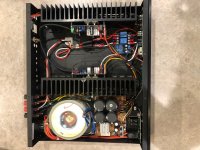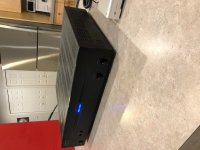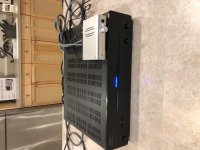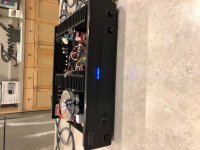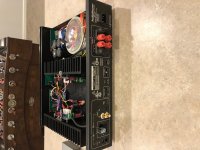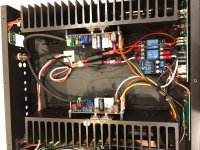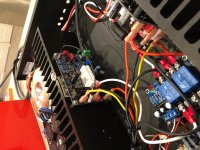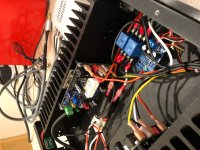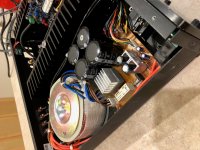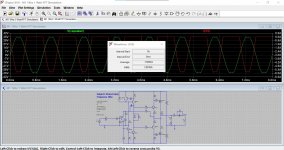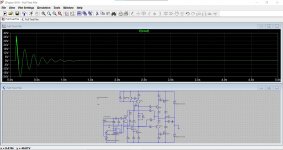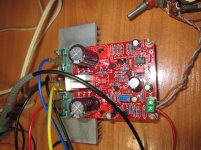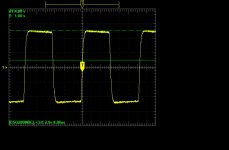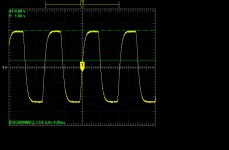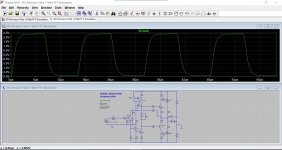I'm back---had some trouble getting the amp be quiet (hum and buzz). Took me a few tried (like 4-5) to get the ground wiring quiet. Thought it was fixed with just the left channel installed, but when I installed the right channel, the ground hum came back. I think it was partly caused by adding speaker protection (from eBay), because I used the +15V from the PSU and I didn't know it shared a ground with the main secondary voltages.
After trying to fix the ground problem with wiring only, I ended up needing to separate the I/P Ground point from the PSU with a 10r 3W resistor. As soon as I added this, the noise floor went extremely low. The transformer still has some mechanical buzz, but the hum can’t be heard without putting your ear on the speaker. Which for me, is plenty quiet since I usually am listening to music not silence.
What’s in the box? 2-channels built from Prasi’s very nice PCB design using 2-pr of outputs inside of a repurposed Audio Source AMP200 case, which is a 2U case, with pretty beefy heatsinks (10”W x 3”H, 2” fins and ¼” base) and a 300W +/-50Vdc supply, which also provides +24Vdc, +/-15Vdc. I also used the IEC and speaker connectors, with new RCA's and removed all unused parts.
Listening impressions (the part you read all this for) – to say I was surprised would be an understatement, it is extremely good. Sorting through the ground issue, I was actually writing it off as ordinary, but fixing that really opened up the sound. Not sure if this can be true, but adding the 6uH inductor, which I did after listening for 3 days without it, seemed to open up the highs a provided more detail. Might be in my head, but to me it immediately sounded better, more clean, clear and the highs came alive. The other aspect I was not expecting was the low end and the punch it has for bass. I would be considered a bass lover, and this has enough that I have been listening with my subwoofer on and running my bookshelves full-range the last 2 days…and really been enjoying it and completely satisfied with the sound.
After listening to this amp fully built for 3 days, I can see why Mooly said "he has never needed another amp, this does it all". I completely agree. This is easy to listen to and doesn't get fatiguing. I am no audiophile, but I really enjoy music and critical listening. I don’t listen to pick out flaws, but to relax, immerse myself and enjoy the music. I will leave it at that and say that with all the amplifiers I have, this immediately took number 1 spot in my listening room and don't see it being removed for some time.
Bonus – it is easy to get boards produced (I got 10 to my door in 2 weeks for $25 from JLCPCB.com) All the parts cost ~$60 for 2-channels (I did have some of the small caps and resistors on hand) and with the repurposed case I paid $50 for years ago a very affordable amplifier that sounds great. Most important part is making sure you get authentic 2SK1058/2SJ162 or the easier/safer route is to order from Profusion and get their Exicon laterals, which you can get matched as well.
I have compared this to my collection of 8+ amps, some I built from offerings here on DIYAudio and others are commercial products. This is right at the top, as far as the sound it reproduces and if you consider the cost – it’s an easy decision. I very well could be redesigning my active 4-channel DSP/Amp system around these in the near future.
Thanks Mooly for this great design and Prasi for the PCB layout and sharing the gerbers!
After trying to fix the ground problem with wiring only, I ended up needing to separate the I/P Ground point from the PSU with a 10r 3W resistor. As soon as I added this, the noise floor went extremely low. The transformer still has some mechanical buzz, but the hum can’t be heard without putting your ear on the speaker. Which for me, is plenty quiet since I usually am listening to music not silence.
What’s in the box? 2-channels built from Prasi’s very nice PCB design using 2-pr of outputs inside of a repurposed Audio Source AMP200 case, which is a 2U case, with pretty beefy heatsinks (10”W x 3”H, 2” fins and ¼” base) and a 300W +/-50Vdc supply, which also provides +24Vdc, +/-15Vdc. I also used the IEC and speaker connectors, with new RCA's and removed all unused parts.
Listening impressions (the part you read all this for) – to say I was surprised would be an understatement, it is extremely good. Sorting through the ground issue, I was actually writing it off as ordinary, but fixing that really opened up the sound. Not sure if this can be true, but adding the 6uH inductor, which I did after listening for 3 days without it, seemed to open up the highs a provided more detail. Might be in my head, but to me it immediately sounded better, more clean, clear and the highs came alive. The other aspect I was not expecting was the low end and the punch it has for bass. I would be considered a bass lover, and this has enough that I have been listening with my subwoofer on and running my bookshelves full-range the last 2 days…and really been enjoying it and completely satisfied with the sound.
After listening to this amp fully built for 3 days, I can see why Mooly said "he has never needed another amp, this does it all". I completely agree. This is easy to listen to and doesn't get fatiguing. I am no audiophile, but I really enjoy music and critical listening. I don’t listen to pick out flaws, but to relax, immerse myself and enjoy the music. I will leave it at that and say that with all the amplifiers I have, this immediately took number 1 spot in my listening room and don't see it being removed for some time.
Bonus – it is easy to get boards produced (I got 10 to my door in 2 weeks for $25 from JLCPCB.com) All the parts cost ~$60 for 2-channels (I did have some of the small caps and resistors on hand) and with the repurposed case I paid $50 for years ago a very affordable amplifier that sounds great. Most important part is making sure you get authentic 2SK1058/2SJ162 or the easier/safer route is to order from Profusion and get their Exicon laterals, which you can get matched as well.
I have compared this to my collection of 8+ amps, some I built from offerings here on DIYAudio and others are commercial products. This is right at the top, as far as the sound it reproduces and if you consider the cost – it’s an easy decision. I very well could be redesigning my active 4-channel DSP/Amp system around these in the near future.
Thanks Mooly for this great design and Prasi for the PCB layout and sharing the gerbers!
Attachments
 and thanks for the kind words
and thanks for the kind words I'm really pleased you are enjoying it (mine is on and playing away as I'm typing this
I like your case as well, it all looks a perfect fit.
Can I ask a simple question, but which I can't seem to do the math? What size fuse are you using for the rails?
I started with a 3A slo blo on the IEC, then (4) 3.15A Fast-blow, which lasted a month of sporadic use, then the left channel popped the negative rail.
I upped them to 4A fast blow, which have worked for 3 months and then today the right channel negative rail popped.
I am thinking of going down to a 2A slo-blow, or maybe a better option is going up to a 5A fast-blow? Not sure which would be better. I have speaker protection, so I'm not worried about my speakers, only that the fuses will give way before the drivers or outputs and damage the amplifier channel.
Thanks,
I started with a 3A slo blo on the IEC, then (4) 3.15A Fast-blow, which lasted a month of sporadic use, then the left channel popped the negative rail.
I upped them to 4A fast blow, which have worked for 3 months and then today the right channel negative rail popped.
I am thinking of going down to a 2A slo-blow, or maybe a better option is going up to a 5A fast-blow? Not sure which would be better. I have speaker protection, so I'm not worried about my speakers, only that the fuses will give way before the drivers or outputs and damage the amplifier channel.
Thanks,
That is a really lovely build!  And an economical, well-suited, re-purposed chassis to boot!
And an economical, well-suited, re-purposed chassis to boot!
The fuse issue is two-fold. The line fuse has to survive the repeating strain of filling up the bulk/main reservoir capacitors. Slow-blows are probably a good choice there. What is the VA rating of your power transformer? And what value are the caps?
The fuses on each amp board don't have quite as tall of a challenge. But odds are that it is still a startup surge that's causing those to pop; some time constant in the circuit is probably causing a brief, heavy cross-conduction before it stabilizes. I would try 3AG - or whatever the going designation is for 'normal' - rather than vacillating between 'slo-' and 'fast-', at least until we know more about the nature of the issue.
Is there perhaps a filter or bypass capacitor on the amp board whose value you've bumped up?
 The failed semiconductors take THEMSELVES out, far faster than any fuse can react, no matter how thoughtfully/carefully specified.
The failed semiconductors take THEMSELVES out, far faster than any fuse can react, no matter how thoughtfully/carefully specified.
But I'll gladly defer to Mooly and/or Prasi (or any of the many wiser-than-me folk on here, for that matter) when they chime in. (I was away for too long myself -- sorry.)
Very fine work. Beautiful!
Regards
The fuse issue is two-fold. The line fuse has to survive the repeating strain of filling up the bulk/main reservoir capacitors. Slow-blows are probably a good choice there. What is the VA rating of your power transformer? And what value are the caps?
The fuses on each amp board don't have quite as tall of a challenge. But odds are that it is still a startup surge that's causing those to pop; some time constant in the circuit is probably causing a brief, heavy cross-conduction before it stabilizes. I would try 3AG - or whatever the going designation is for 'normal' - rather than vacillating between 'slo-' and 'fast-', at least until we know more about the nature of the issue.
Is there perhaps a filter or bypass capacitor on the amp board whose value you've bumped up?
Well, a 2A slo-blow is nominally safer than a 5A fast-blow. But expecting ANY fuse to protect the semiconductors, is to invite disappointment. Even if you spring for 'instrument-grade' fuses, a semiconductor fails several orders of magnitude faster -- a few microseconds above the SOA can be all it takes. Fuses are to reduce fires and scorched circuit boards -- the collateral damage.I am thinking of going down to a 2A slo-blow, or maybe a better option is going up to a 5A fast-blow? Not sure which would be better. I have speaker protection, so I'm not worried about my speakers, only that the fuses will give way before the drivers or outputs and damage the amplifier channel.
 The failed semiconductors take THEMSELVES out, far faster than any fuse can react, no matter how thoughtfully/carefully specified.
The failed semiconductors take THEMSELVES out, far faster than any fuse can react, no matter how thoughtfully/carefully specified.But I'll gladly defer to Mooly and/or Prasi (or any of the many wiser-than-me folk on here, for that matter) when they chime in. (I was away for too long myself -- sorry.)
Very fine work. Beautiful!

Regards
Last edited:
Fuses...
The mains inlet depends on the VA rating of the transformer. Lets say its 300VA and your mains is 120 volt. So at a basic level we 300/120 which is 2.5A but that does not cover inrush current. You are going to need at least a 4A Anti Surge type fuse for the mains inlet.
Rail fuses are a different matter. There should be no surges here, the exception would be if you had a speaker delay circuit that was not effective and that allowed the speaker to be connected at the instant of power on.
The big question is whether it blows in use listening to music or whether it blows at switch on. When exactly does it blow This is the most important question.
Lets look at the amp under full drive into 6 ohms which in practice would be pretty extreme. This in on 45 volt rails and driven up to clipping. The current in one rail is shown. The other rail is a mirror image. The peak current is nearly 6 amps. The simulation has calculated the RMS and average current.
So what to use. Peaks can draw around 6 A, more if the load is adverse. Its extreme use though although if you want fast blow you have to cover the worst case peaks. Slow blow and you will get away with lower for any normal use. I would think 4 amp anti surge for the rails should cover pretty much any usage tbh.
The mains inlet depends on the VA rating of the transformer. Lets say its 300VA and your mains is 120 volt. So at a basic level we 300/120 which is 2.5A but that does not cover inrush current. You are going to need at least a 4A Anti Surge type fuse for the mains inlet.
Rail fuses are a different matter. There should be no surges here, the exception would be if you had a speaker delay circuit that was not effective and that allowed the speaker to be connected at the instant of power on.
The big question is whether it blows in use listening to music or whether it blows at switch on. When exactly does it blow This is the most important question.
Lets look at the amp under full drive into 6 ohms which in practice would be pretty extreme. This in on 45 volt rails and driven up to clipping. The current in one rail is shown. The other rail is a mirror image. The peak current is nearly 6 amps. The simulation has calculated the RMS and average current.
So what to use. Peaks can draw around 6 A, more if the load is adverse. Its extreme use though although if you want fast blow you have to cover the worst case peaks. Slow blow and you will get away with lower for any normal use. I would think 4 amp anti surge for the rails should cover pretty much any usage tbh.
Attachments
Thanks for the help.
No changes to the suggested BOM on both channels.
Speaker protection is a cheap dual channel from China.
The repurposed amp, is basically the same power but had 2-pr of bjts. About 80w at 8-ohms and 120w at 4-ohms. So likely it is 250-300VA xfrmr running +/-50V rails.
I will go to a 5A surge proof in the IEC and will get some 3-4A slo-blo to try on the amp rails.
It is only the turn on I have issue with, that was when the rails blew both times and I listen in an office so not driven hard.
No changes to the suggested BOM on both channels.
Speaker protection is a cheap dual channel from China.
The repurposed amp, is basically the same power but had 2-pr of bjts. About 80w at 8-ohms and 120w at 4-ohms. So likely it is 250-300VA xfrmr running +/-50V rails.
I will go to a 5A surge proof in the IEC and will get some 3-4A slo-blo to try on the amp rails.
It is only the turn on I have issue with, that was when the rails blew both times and I listen in an office so not driven hard.
Nothing in the design has changed at all.
The rail fuses on the actual amp boards themselves should see no large surge currents at power on because there are no large caps on the rails after the fuses. All the big caps are in the power supply should be before the boards.
I have to wonder over the speaker protection board. It is so important that this is fool proof and does not connect the speaker before the amp has settled. If you ever hear any noise or pops from the speaker at the instant you power up then that proves the speaker protection circuit isn't doing its job and giving a reliable delay.
If you use this in an office situation at modest levels then why not as a test add an inline fuse to each speaker, perhaps just 1A fast blow, and see if and when this happens again whether it is now this fuse that blows and not a rail fuse.
That would prove conclusively that the problem is the speaker being connected when it should not be.
At this point maybe don't overdo things on the rail fuses, lets try and pin down where the issue is first of all.
The rail fuses on the actual amp boards themselves should see no large surge currents at power on because there are no large caps on the rails after the fuses. All the big caps are in the power supply should be before the boards.
I have to wonder over the speaker protection board. It is so important that this is fool proof and does not connect the speaker before the amp has settled. If you ever hear any noise or pops from the speaker at the instant you power up then that proves the speaker protection circuit isn't doing its job and giving a reliable delay.
If you use this in an office situation at modest levels then why not as a test add an inline fuse to each speaker, perhaps just 1A fast blow, and see if and when this happens again whether it is now this fuse that blows and not a rail fuse.
That would prove conclusively that the problem is the speaker being connected when it should not be.
At this point maybe don't overdo things on the rail fuses, lets try and pin down where the issue is first of all.
I think it is a confluence of two things:
- the protection kicks in at about 3-4 secs (which probably not long enough)
- and the computer is already playing music so their is current on the speakers at turn-on instant.
I will see if I can pin point the issue first and will try and have music paused at power on. I will also try and lengthen turn on to 5+ secs.
- the protection kicks in at about 3-4 secs (which probably not long enough)
- and the computer is already playing music so their is current on the speakers at turn-on instant.
I will see if I can pin point the issue first and will try and have music paused at power on. I will also try and lengthen turn on to 5+ secs.
Three to four seconds should get over the worst of any initial noise.
If you switch on the amp with no music playing then at the instant the speakers connect you ideally want to have no detectable noise (thump) from the speaker.
It would take a big voltage to pull enough current to blow a rail fuse and you would really know about that from the 'bang' from the speaker as it protests.
If that isn't happening then maybe something else is going on.
Could the presence of any high level audio at the input at the moment of switch on do anything even though the speakers are not connected... its hard to see that it could though... or at least it would have to be very very high in level so that it swamps the input stage... even then though I can't imagine the output stage doing anything untoward with no load connected.
I think you just have to be methodical at this stage and gather evidence as to what happens. The low value fuse to the speaker is a good initial test. If the rail fuse pops and leaves a low value speaker fuse intact then we are looking elsewhere.
Adding a mute delay to the input should be pretty easy to do if needed. A shorting relay that opens after a couple of seconds. It could perhaps even be powered from the speaker relay drive.
If you switch on the amp with no music playing then at the instant the speakers connect you ideally want to have no detectable noise (thump) from the speaker.
It would take a big voltage to pull enough current to blow a rail fuse and you would really know about that from the 'bang' from the speaker as it protests.
If that isn't happening then maybe something else is going on.
Could the presence of any high level audio at the input at the moment of switch on do anything even though the speakers are not connected... its hard to see that it could though... or at least it would have to be very very high in level so that it swamps the input stage... even then though I can't imagine the output stage doing anything untoward with no load connected.
I think you just have to be methodical at this stage and gather evidence as to what happens. The low value fuse to the speaker is a good initial test. If the rail fuse pops and leaves a low value speaker fuse intact then we are looking elsewhere.
Adding a mute delay to the input should be pretty easy to do if needed. A shorting relay that opens after a couple of seconds. It could perhaps even be powered from the speaker relay drive.
This shows the speaker output when power is applied. The servo creates a damped oscillation that finally settles to zero.
Although it takes several seconds before the output is truly at zero volts (for a 100% silent speaker connect) the main action is over in a couple of seconds.
To blow a fuse would mean the speaker was connecting in those first few moments... if that is what is happening.
Although it takes several seconds before the output is truly at zero volts (for a 100% silent speaker connect) the main action is over in a couple of seconds.
To blow a fuse would mean the speaker was connecting in those first few moments... if that is what is happening.
Attachments
Yes, have a look at Exicon:
ECX10N20 Plastic Lateral MOSFET | Profusion
and:
ECX10P20 Plastic Lateral MOSFET | Profusion
Lateral MOSFETs (Buy Online) | Profusion
ECX10N20 Plastic Lateral MOSFET | Profusion
and:
ECX10P20 Plastic Lateral MOSFET | Profusion
Lateral MOSFETs (Buy Online) | Profusion
- Home
- Amplifiers
- Solid State
- My MOSFET amplifier designed for music
